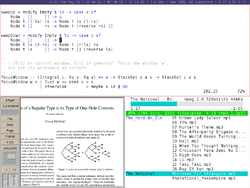Software:xmonad
 | |
 xmonad in tiling mode | |
| Original author(s) | Spencer Janssen, Don Stewart, Jason Creighton |
|---|---|
| Initial release | March 6, 2007[1] |
| Written in | Haskell |
| Operating system | POSIX compatible |
| Platform | Cross-platform; requires an X Window System and GHC |
| Size | 56 KB (source code)[2] |
| Available in | English |
| Type | Window manager |
| License | BSD 3-clause |

xmonad is a dynamic window manager (tiling) for the X Window System, noted for being written in the functional programming language Haskell.[3][4]
Window manager
Begun in March 2007, version 0.1 was announced[5] in April 2007 as 500 lines of Haskell[6] (which have since grown to 2000 lines). xmonad is a tiling window manager—akin to dwm, larswm, and StumpWM. It arranges windows in a non-overlapping pattern, and enables managing windows without using the mouse. xmonad is packaged and distributed on a wide range of Unix-like operating systems, such as a large number of Linux distributions, and Berkeley Software Distribution (BSD) systems.
While originally a clone of dwm (derivative in areas such as default keybindings), xmonad now supports features not available to dwm users[7][8] such as per-workspace layout, tiling reflection, state preservation, layout mirroring, GNOME support and per-screen status bars; it can be customised by modifying an external configuration file and 'reloaded' while running.[9] xmonad features have begun to influence other tiling window managers: dwm has borrowed "urgency hooks" from xmonad,[10] has also included Xinerama support (for multihead displays) with release 4.8, and patches exist to reimplement xmonad's Fibonacci layout.[11]
Haskell project
In 2023 the man page stated:
By utilising the expressivity of a modern functional language with a rich static type system, xmonad provides a complete, featureful window manager [...], with an emphasis on correctness and robustness. Internal properties of the window manager are checked using a combination of static guarantees provided by the type system, and type-based automated testing. A benefit of this is that the code is simple to understand, and easy to modify.[12]
Since xmonad's inception, when its small code size of 500 lines of code was advertised, it has grown to ca. 2000 lines in 2023.
Extensions to the core system, including emulation of other window managers, and unusual layout algorithms, such as window tiling based on the Fibonacci spiral—have been implemented by the active community[13] and are available as a library.[14]
Along with obviating the need for a mouse,[15] the xmonad developers make heavy use of semi-formal methods and program derivation for improving reliability and enabling a total line of code count less than 1200, as of version 0.7; window manager properties (such as the behavior of window focus) are checked through use of QuickCheck.[16] This emphasis makes xmonad unusual in a number of ways; besides being the first window manager written in Haskell, it is also the first to use the zipper data structure for automatically managing focus, and its core has been proven to be safe with respect to pattern matches,[17] contributing further to reliability. The developers write:
xmonad is a tiling window manager for the X Window system, implemented, configured and dynamically extensible in Haskell. This demonstration presents the case that software dominated by side effects can be developed with the precision and efficiency we expect from Haskell by utilising purely functional data structures, an expressive type system, extended static checking and property-based testing. In addition, we describe the use of Haskell as an application configuration and extension language.[18]
The code is separated into side-effect free code, and a thin wrapper for the side-effects.[19] According to Alejandro Serrano Mena, there are two ways of implementing domain-specific languages for actions in Haskell applications and libraries: "developing a combinator library" or "rolling your own monad", with xmonad being a successful example of the latter.[20] xmonad was regarded as one of the most well known Haskell projects in a 2013 functional programming book.[4]
Reception
Linux Magazine included xmonad in a list of "My Top Resources of 2009".[21] In 2012, How-To Geek described xmonad as having good, but complex, ability to be configured,[22] and it was included in a 2013 list of eight desktop environments for Linux.[23] Lifehacker wrote that the basic operations of xmonads user interface can be taught using a small set of instructions.[24] A high level of customisation and speed were noted by Network World,[3] and in MakeUseOf xmonad was reviewed positively compared to Openbox.[25]
In 2016 Ars Technica said xmonad and Awesome had more advanced tiling ability than Cinnamon.[26] In 2017 it was described as powerful, with application as a windows manager for big data,[27] while in an article on opensource.com on the other hand, dwm was chosen over xmonad.[28] A TechRadar review of the "Best Linux desktop of 2018" said "If there's one desktop environment that stands out from all the others we have here, it's this one."[29]
Due to the small number of lines of code of the Xmonad application, the use of the purely functional programming language Haskell, and recorded use of a rigorous testing procedure it is sometimes used as a baseline application in other research projects. This has included re-implementation of xmonad using the Coq proof assistant,[30] a determination xmonad is an imperative program,[31] and studies of package management relating to the NixOS linux distribution.[32]
See also
References
- ↑ "Initial import: xmonad/xmonad@b2c1430". https://github.com/xmonad/xmonad/commit/b2c14305a25ef954f26edfdc29c63a4875f58165.
- ↑ "xmonad: download". suckless.org. http://xmonad.org/download.html.
- ↑ Jump up to: 3.0 3.1 Lunduke, Bryan (15 May 2013). "10 amazing Linux desktop environments you've probably never seen". Network World. xmonad. https://www.networkworld.com/article/2356810/linux/100941-10-amazing-Linux-desktop-environments-youve-probably-never-seen.html#slide2.
- ↑ Jump up to: 4.0 4.1 Ohlig, Jens; Mehnert, Hannes; Schirmer, Stefanie (24 September 2018). Das Curry-Buch – Funktional programmieren lernen mit JavaScript. O'Reilly Germany. p. 177. ISBN 978-3868993691. https://books.google.com/books?id=GZZbAAAAQBAJ.
- ↑ Janssen, Spencer (2007-04-22). "Announce: xmonad 0.1". Haskell-cafe (Mailing list). Archived from the original on 2021-08-30. Retrieved 2021-08-30.
- ↑ "Xmonad: a Tiling Window Manager Written in Haskell". OSNews. 2007-05-22. http://www.osnews.com/story/17744/Xmonad-a-Tiling-Window-Manager-Written-in-Haskell.
- ↑ "Keyboard-Driven Environments Open a New Window". OSNews. 2007-05-31. http://www.osnews.com/story.php/18009/Keyboard-Driven-Environments-Open-a-New-Window/.
- ↑ "xmonad 0.4 Released". OSNews. 2007-10-19. http://osnews.com/story.php/18794/xmonad-0.4-Released.
- ↑ Through a combination of swiftly re-compiling and then execing the new xmonad binary; see "Haskell Weekly News: April 27, 2007". Haskell Weekly News. 2007-04-27. http://sequence.complete.org/hwn/20070427.
- ↑ See the developer discussion on the dwm mailing list
- ↑ Suckless.org: Fibonacci layouts patch to dwm
- ↑ "Manpage of xmonad". xmonad.org. 2021-10-27. http://www.xmonad.org/manpage.html.
- ↑ xmonad users generate significant traffic in the #xmonad Internet Relay Chat (IRC) channel and the xmonad mailing list; also, there are a many commits to the extension library from non-core devs (see the xmonad statistic page )
- ↑ "xmonad: Contributed code". xmonad.org. 2007-05-22. http://xmonad.org/contrib.html.
- ↑ Mitchell, Neil (June 2008). "6.5.5". Transformation and Analysis (PDF) (PhD). University of York. Archived (PDF) from the original on 12 September 2018. Retrieved 12 September 2018.
- ↑ Hu, Zhenjiang; Hughes, John; Wang, Meng (2015). "How functional programming mattered". National Science Review 2 (3): 350–351. doi:10.1093/nsr/nwv042. ISSN 2095-5138. https://kar.kent.ac.uk/50323/1/matter.pdf. Retrieved 27 September 2018.
- ↑ Mitchell, Neil (9 May 2007). "Neil Mitchell's Haskell Blog: Does XMonad crash?". http://neilmitchell.blogspot.com/2007/05/does-xmonad-crash.html.
- ↑ Stewart & Janssen, 2007
- ↑ Warden, Shane; Biancuzzi, Federico (2009). Masterminds of Programming: Conversations with the Creators of Major Programming Languages. O'Reilly Media. p. 181. ISBN 978-0596515171. http://shop.oreilly.com/product/9780596515171.do. Retrieved 2018-09-18.
- ↑ Mena, Alejandro Serrano (5 March 2014). Beginning Haskell: A Project-Based Approach. Apress. p. 385. ISBN 9781430262510. https://books.google.com/books?id=IZsQAwAAQBAJ. Retrieved 2018-09-24.
- ↑ Zawodny, Jeremy (2009-12-06). "My Top Resources of 2009". Linux Magazine. http://www.linux-mag.com/id/7639/.
- ↑ Hoffman, Chris (2012-05-24). "How to Use Xmonad, a Tiling Window Manager for Linux". How-To Geek. https://www.howtogeek.com/114728/how-to-use-xmonad-a-tiling-window-manager-for-linux/.
- ↑ Hoffman, Chris (2013-05-18). "Linux Users Have a Choice: 8 Linux Desktop Environments". How-To Geek. https://www.howtogeek.com/163154/linux-users-have-a-choice-8-linux-desktop-environments/.
- ↑ Goerzen, John (2013-01-08). "I Raised My Kids On the Command Line...and They Love It". Lifehacker. Univision Communications. https://lifehacker.com/5974087/i-raised-my-kids-on-the-command-lineand-they-love-it.
- ↑ Stieben, Danny (2018-09-18). "Need A Fresh Desktop Environment for Linux? Try Openbox Or xmonad". https://www.makeuseof.com/tag/need-a-fresh-desktop-environment-for-linux-try-openbox-or-xmonad/.
- ↑ "Mint 18 review: "Just works" Linux doesn't get any better than this". Ars Technica. 2016-08-04. https://arstechnica.com/information-technology/2016/08/mint-18-review-just-works-linux-doesnt-get-any-better-than-this/2/.
- ↑ Nita, Stefania Loredana; Mihailescu, Marius (14 September 2017). Practical Concurrent Haskell: With Big Data Applications. Apress. pp. 40–41. ISBN 978-1484227800. https://www.amazon.co.uk/Practical-Concurrent-Haskell-Data-Applications-ebook/dp/B075MZ6CJK/ref=sr_1_1?s=books&ie=UTF8&qid=1537205386&sr=1-1&keywords=9781484227817.
- ↑ "Top 4 reasons I use dwm for my Linux window manager". Red Hat. 2017-07-18. https://opensource.com/article/17/7/top-4-reasons-i-use-dwm-linux-window-manager.
- ↑ "Best Linux desktop of 2018". Future plc. 2018-01-15. https://www.techradar.com/uk/news/best-linux-desktop.
- ↑ Swierstra, Wouter (13 September 2012). "xmonad in Coq (Experience Report) Programming a Window Manager with a Proof Assistant". in Voigtländer, J.. ICFP 2012 The 17th ACM SIGPLAN International Conference on Functional Programming. Copenhagen, Denmark: Association for Computing Machinery. pp. 131–136. ISBN 978-1-4503-1574-6.
- ↑ Lippmeier, Ben (May 2010). Type Inference and Optimisation for an Impure World (PDF) (PhD). Australian National University. pp. 45–46. Archived from the original on 2018-09-27.CS1 maint: unfit url (link)
- ↑ Dolstra, Eelco; LÖH, Andres; Pierron, Nicolas (November 2010). "NixOS: A Purely Functional Linux Distribution". Journal of Functional Programming 20 (5–6): 577–615. doi:10.1017/S0956796810000195. ISSN 0956-7968. http://resolver.tudelft.nl/uuid:547a1af2-10e5-4a00-a87b-5f47dde83b1f.
Works cited
- Stewart, Don; Janssen, Spencer (September 2007). "Xmonad". Proceedings of the ACM SIGPLAN workshop on Haskell workshop. pp. 119. doi:10.1145/1291201.1291218. ISBN 978-1-59593-674-5. http://www.cse.unsw.edu.au/~dons/papers/haskell51d-stewart.pdf. Retrieved 2007-10-22.
Further reading
- Lunduke, Bryan (2018-02-05). Half a Decade of Linux-y Shenanigans. Bryan Lunduke. p. 5. ISBN 9781387571246. https://books.google.com/books?id=Eq9XDwAAQBAJ. According to Bryan Lunduke xmonad is an unknown desktop environment written in an unknown programming language, adding "Are xmonad and Haskell failures? Are they dead? No. Because they are unique. They are customizable. They are alive and kicking (and awesome)."
- Tucker, Ronnie (29 November 2013). "Full Circle Magazine #79: The Independent Magazine for the Ubuntu Linux Community". Full Circle. Full Circle Team. https://books.google.com/books?id=VONjBAAAQBAJ. – the use of xmonad and other lightweight window managers
External links
- "Taste of Haskell" – O'Reilly Open Source Convention (OSCON) presentation by Simon Peyton Jones on Haskell, using xmonad as an example
- First half of talk on YouTube (video)
- Second half of talk on YouTube (video)
 |


